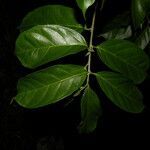Trees to about 15 m. in height. Leafy twigs rather slender, somewhat flexuose, glabrous, developing a yellowish gray bark. Leaves alternate, distichous, petiolate, the blade broadly oval to elliptic-oblong, occasionally irregularly pandurate, the tip subcaudate-acuminate, the base essentially equilateral and rounded to broadly obtuse, entire or somewhat serrate-undulate toward the tip, 6-20 cm. long, 2-9 cm. broad, firmly membranaceous, glabrous, the petiole 5-7 mm. long; stipules lateral, narrowly lanceolate, about 5 mm. long. Staminate spikes slender, 3-5 cm. long, bearing innumerable densely congested flowers interspersed with minute shortly stipitate peltate bracts: tepals 4, somewhat united at the base, broadly oval, about 2 mm. long, minutely papillate; stamens 4, the filaments about 3 mm. long, the anthers about 0.5 mm. long. Pistillate spikes rather short and strongly secund, 1.0-1.5 cm. long, densely and minutely ferruginous-puberulent, bearing rather few and distant sessile truncate conic flowers about 2 mm. long: perianth lobes minutely trigonal; stigma lobes about 1.5 mm. long. Fruits globose or ovoid, up to about 1 cm. long, reddish or yellowish, minutely puberulent.
More
A tree. It grows 21 m tall. The bark is smooth and grey but becomes scaly with age. It has milky sap. The leaves are alternate and narrow. The male flowers are in catkin like clusters. The female flowers are in short catkins and the male and female flowers occur on separate trees. The fruit are small and edible.





